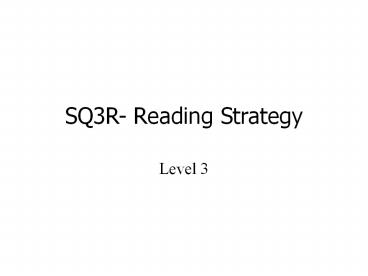SQ3R- Reading Strategy - PowerPoint PPT Presentation
Title:
SQ3R- Reading Strategy
Description:
SQ3R- Reading Strategy Level 3 Survey! Question! Read! Recite! Review! Before you read, Survey the chapter: the title, headings, and subheadings captions under ... – PowerPoint PPT presentation
Number of Views:354
Avg rating:3.0/5.0
Title: SQ3R- Reading Strategy
1
SQ3R- Reading Strategy
- Level 3
2
Survey! Question! Read! Recite! Review!
- Before you read, Surveythe chapter
- the title, headings, and subheadings
- captions under pictures, charts, graphs or maps
- review questions or teacher-made study guides
- introductory and concluding paragraphs
- summary
3
- Questionwhile you are surveying
- Turn the title, headings, and/or subheadings into
questions - Read questions at the end of the chapters or
after each subheading - Ask yourself, "What did my instructor say about
this chapter or subject when it was assigned?" - Ask yourself, "What do I already know about this
subject?" - Note If it is helpful to you, write out these
questions for consideration. This variation is
called SQW3R
4
- Reciteafter you've read a section
- Orally ask yourself questions about what you have
just read or summarize, in your own words, what
you read - Take notes from the text but write the
information in your own words - Underline or highlight important points you've
just read - Use the method of recitation which best suits
your particular learning style but remember, the
more senses you use the more likely you are to
remember what you read - i.e., - TRIPLE STRENGTH LEARNING Seeing, saying,
hearing-QUADRUPLE STRENGTH LEARNING Seeing ,
saying , hearing, writing!!!
5
- When you begin toRead
- Look for answers to the questions you first
raised - Answer questions at the beginning or end of
chapters or study guides - Reread captions under pictures, graphs, etc.
- Note all the underlined, italicized, bold printed
words or phrases - Study graphic aids
- Reduce your speed for difficult passages
- Stop and reread parts which are not clear
- Read only a section at a time and recite after
each section
6
- Reviewan ongoing process
- write questions for the notes you have taken
- Make "flash cards"
- Develop mnemonic devices for material which need
to be memorized.
Adapted from Robinson, Francis Pleasant, (1961,
1970) Effective study (4th ed.), Harper Row,
New York, NY.
7
http//www.teach-nology.com/cgi-bin/sq3r.cgi
http//www.ucc.vt.edu/stdysk/sq3r.html
http//www.arc.sbc.edu/sq3r.html
Use These!































